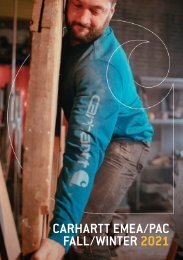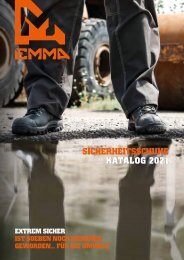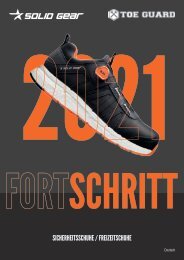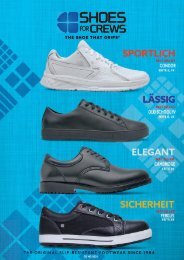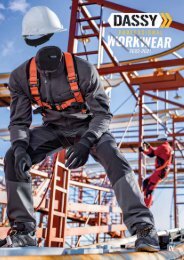Haix Schuhe Katalog
Erfolgreiche ePaper selbst erstellen
Machen Sie aus Ihren PDF Publikationen ein blätterbares Flipbook mit unserer einzigartigen Google optimierten e-Paper Software.
HAIX ® SOHLEN SOLES SEMELLES<br />
HAIX ® STANDARDS<br />
Sicherheitskennzeichnung (CE)<br />
Designation of safety (CE)<br />
Codification et sécurité (CE)<br />
Eigenschaften<br />
Properties<br />
Propriétés<br />
027<br />
011<br />
Gummiprofilschalensohle / Rubber tread<br />
shell sole / Semelle profilée en caoutchouc • •<br />
017<br />
05<br />
016<br />
08<br />
051<br />
Gummiprofil - PU-Zwischensohle / Rubber<br />
tread - PU midsole / Profilé caoutchouc -<br />
• • • • • • • • • • • • • • • •<br />
semelle intermédiaire PU<br />
TPU Profilsohle - PU Zwischensohle /<br />
TPU tread sole - PU midsole / Semelle<br />
profilée TPU - semelle intermédiaire PU<br />
•<br />
Straßenprofil / Street tread / Profil route<br />
• • • • • • • • • • • • •<br />
Geländeprofil / Terrain tread /<br />
Profil tout-terrain • • • • • • • • • • • • • • • •<br />
Öl - benzinbeständig / Oil and gasolineproof<br />
/ Résistante à l’huile et à l‘essence • • • • • • • • • • • • • • • • • •<br />
Antistatisch / Antistatic / Antistatique<br />
• • • • • • • • • • • • • • • • •<br />
Nicht kreidend / Non-chalking /<br />
Ne marque pas • • • • • • • • • • • • • • • • • • •<br />
Absatzfront 90 Grad mit Leiterstegprofilierung<br />
/ Heel front 90 degrees with<br />
ladder web profile / Front de talon 90<br />
degrés avec profil pour échelle<br />
DIN EN ISO 20345 für Sicherheitsschuhe /<br />
DIN EN ISO 20345 for safety shoes /<br />
DIN EN ISO 20345 pour chaussures de<br />
sécurité<br />
DIN EN ISO 20347 für Berufsschuhe /<br />
DIN EN ISO 20347 for work shoes /<br />
DIN EN ISO 20347 pour chaussures<br />
professionnelles<br />
026<br />
• • • •<br />
012<br />
• • • • • • • • • •<br />
020<br />
018<br />
• • • • • • • •<br />
Hohe Dämpfungseigenschaft /<br />
High damping properties /<br />
• • • • • • • • • • • • • • • • • •<br />
Grande propriété isolante<br />
Spezielles Lamellenprofil für höchste<br />
Rutschsicherheit / Special siped tread for<br />
greatest non-slip safety / Profil spécial<br />
en lamelles pour la meilleure sécurité<br />
antidérapante<br />
• • • • • • • • • • •<br />
Kontaktwärmebeständigkeit /<br />
Contact heat proof / Résistante à la<br />
• • • • • • • • • • • • • • • • • •<br />
chaleur de contact HRO (300°C / 1 min.)<br />
Wärmeisolierung des Sohlenkomplexes<br />
/ Heat insulation of the sole complex /<br />
Isolation de l’ensemble de la semelle à la<br />
chaleur HI (150°C / 30 min.)<br />
Kälteisolierung des Sohlenkomplexes /<br />
Cold insulation of the sole complex /<br />
Isolation de l’ensemble de la semelle au<br />
froid CI (-17°C / 30 min.)<br />
Wärmeisolierung gem. EN 15090 /<br />
Heat insulation pursuant to EN 15090 /<br />
Isolation à la chaleur selon EN 15090<br />
HI3 (250 °C / 40 min.)<br />
• • • • • • • • • • • • • • • • • • •<br />
• • • • • • • • • • • • • • • • • •<br />
• • •<br />
Profilerneuerung / Re-treading /<br />
Renouvellement du profil • • • • • • • • • • • • • • •<br />
019<br />
050<br />
015<br />
023<br />
024<br />
028<br />
029<br />
030<br />
Kennzeichnung der Kategorien von<br />
Sicherheitsschuhen DIN EN ISO 20345<br />
SB: Grundanforderungen lt. Norm<br />
(u. a. Zehenschutzkappe)<br />
S1: Wie „SB“, zzgl. geschlossener Fersenbereich,<br />
Antistatik, Energieaufnahmevermögen im<br />
Fersenbereich, Kraftstoffbeständigkeit<br />
S2: Wie S1, zusätzlich Anforderungen an Wasserdurchtritt<br />
und Wasseraufnahme erfüllt<br />
S3: Wie S2, zusätzlich Durchtrittsicherheit,<br />
Profilsohle<br />
Kennzeichnung der Kategorien von Berufsschuhen<br />
DIN EN ISO 20347<br />
OB: Grundanforderungen lt. Norm<br />
O2: Geschlossener Fersenbereich, Antistatik,<br />
Energieaufnahmevermögen im Fersenbereich,<br />
Anforderung an Wasserdurchtritt und Wasseraufnahme<br />
O3: Wie O2, zusätzlich Durchtrittsicherheit,<br />
Profilsohle<br />
Bedeutung der Zusatzanforderungen<br />
(Auszug aus EN ISO 20345 / 20347)<br />
E: Energieaufnahmevermögen im Fersenbereich<br />
HI: Wärmeisolierung des Sohlenkomplexes<br />
CI: Kälteisolierung des Sohlenkomplexes<br />
WR: Wasserdichtheit der <strong>Schuhe</strong><br />
WRU: Wasserdurchtritt und Wasseraufnahme<br />
HRO: Verhalten der Laufsohle gegenüber<br />
Kontaktwärme (300°)<br />
M: Mittelfußschutz<br />
AN: Knöchelschutz<br />
FO: Kraftstoffbeständigkeit der Laufsohle<br />
P: Durchtrittsicherheit der Sohle<br />
Klassifizierung von <strong>Schuhe</strong>n nach<br />
DIN EN 15090 / DIN EN ISO 20345 / 20347<br />
Code I: <strong>Schuhe</strong> aus Leder oder anderen Materialien,<br />
mit Ausnahme von Vollgummi- oder Gesamtpolymerschuhen<br />
Code II: Vollgummischuhe oder Gesamtpolymerschuhe<br />
Typen von <strong>Schuhe</strong>n für die Feuerwehr nach<br />
DIN EN 15090<br />
Typ 1: Außeneinsätze, Brand- und Waldbrandbekämpfung;<br />
kein Schutz gegen Durchtritt, kein<br />
Zehenschutz, kein Schutz gegen chemische<br />
Gefahren.<br />
Typ 2: Sämtliche Brandbekämpfungs- und Rettungseinsätze,<br />
bei denen Schutz gegen Durchtritt<br />
und Zehenschutz benötigt werden, kein Schutz<br />
gegen chemische Gefahren.<br />
Die Angabe des Typs und der Schutzfunktion von <strong>Schuhe</strong>n<br />
für die Feuerwehr erfolgt in der unteren rechten<br />
Ecke des Piktogramms (Feuerwehrmann):<br />
F1PA: Alle normativen Grundanforderungen und die<br />
Anforderungen zur Durchtrittsicherheit und<br />
zur Antistatik<br />
F2A: Alle normativen Grundanforderungen und die<br />
Anforderungen zur Antistatik + HI3<br />
Bedeutung der Kennzeichnungssymbole<br />
HI1: Leistungsniveau der Wärmeisolierung des<br />
Sohlenkomplexes bei 150° C / 30 min.<br />
HI3: Leistungsniveau der Wärmeisolierung des<br />
Sohlenkomplexes bei 250° C / 40 min.<br />
Designation of safety shoe categories<br />
DIN EN ISO 20345<br />
SB: Basic requirements as per standard (inc. toe<br />
cap)<br />
S1: As „SB“, plus closed heel area, antistatic,<br />
energy absorbtion capacity in heel area,<br />
oil & fuel resistant<br />
S2: As S1, additional requirements in terms of<br />
water penetration and water absorption<br />
S3: As S2, additional penetration protection,<br />
profile sole<br />
Designation of professional shoe categories<br />
DIN EN ISO 20347<br />
OB: Basic requirements as per standard<br />
O2: Closed heel area, antistatic, energy absorbtion<br />
capacity in heel area, additional requirements in<br />
terms of water penetration and water absorption<br />
O3: As O2, additional penetration protection,<br />
profile sole<br />
Meanings of additional requirements<br />
(Extract from EN ISO 20345 / 20347)<br />
E: Energy absorbtion of seat region<br />
HI: Heat insulation of sole complex<br />
CI: Cold insulation of sole complex<br />
WR: Water resistance of shoes<br />
WRU: Water penetration and water absorption<br />
HRO: Behaviour of sole with regards to contact heat<br />
(300°)<br />
M: Metarsal protection<br />
AN: Ankle protection<br />
FO: Fuel resistance of sole<br />
P: Penetration resistance of sole<br />
Classification of shoes in compliance with<br />
DIN EN 15090 / DIN EN ISO 20345 / 20347<br />
Code I: Shoes made of leather or other materials, not<br />
including full rubber or full polymer shoes<br />
Code II: Shoes made of full rubber or full polymer<br />
Types of fire fighter shoes acc. to DIN EN 15090<br />
Type 1: Outdoor interventions, fire and wildland firefighting;<br />
no protection against penetration, no<br />
toe protection, no protection against chemical<br />
hazards.<br />
Type 2: All fire suppression and rescue interventions<br />
where protection against penetration, and toe<br />
protection are needed, no protection against<br />
chemical hazards.<br />
The type and protective function of fire fighting shoes<br />
is indicated in the bottom right-hand corner of the<br />
pictogram (fireman)<br />
F1PA: All normative basic requirements and the<br />
requirements for penetration resistance and for<br />
antistatic properties<br />
F2A: All normative basic requirements and the<br />
requirements for antistatic properties + HI3<br />
Meaning of the marking symbols<br />
HI1: Level of heat insulation of the sole complex at<br />
150° C / 30 min.<br />
HI3: Level of heat insulation of the sole complex at<br />
250° C / 40 min.<br />
Codification des catégories de chaussures<br />
de sécurité DIN EN ISO 20345<br />
SB: Critères fondamentaux selon la norme<br />
(embout de protection des orteils, entre autres)<br />
S1: Comme „SB“, avec en plus zone du talon<br />
fermée, antistatique, pouvoir d‘absorption de<br />
l‘énergie<br />
au niveau du talon, huile et carburant résistant<br />
S2: Comme S1, résistance supplémentaire à la<br />
pénétration de l’eau et à l’absorption de l’eau<br />
S3: Comme S2, plus sécurité de pénétration,<br />
semelle profilée<br />
Codification des catégories de chaussures<br />
professionnelles, DIN EN ISO 20347<br />
OB: Critères fondamentaux selon la norme<br />
O2: Comme O1, résistance supplémentaire à la<br />
pénétration de l’eau et à l’absorption de l’eau<br />
O3: Comme O2, plus sécurité de pénétration,<br />
semelle profilée<br />
Signification des critères supplémentaires<br />
(Extrait de la norme EN ISO 20345 / 20347)<br />
E: Absorption d’énergie du talon<br />
HI: Isolation de l’ensemble de la semelle à la<br />
chaleur<br />
CI: Isolation de l’ensemble de la semelle au froid<br />
WR: Etanchéité des chaussures à l’eau<br />
WRU: L‘absorption d‘eau et pénétration de l‘eau<br />
HRO: Comportement de la semelle extérieure par<br />
rapport à la chaleur de contact (300°)<br />
M: Protection du métatarse<br />
AN: Protection de la cheville<br />
FO: Résistance de la semelle de marche aux<br />
carburants<br />
P: Anti-perforation d´intersemelle<br />
Classification de chaussures selon la norme<br />
DIN EN 15090 / DIN EN ISO 20345 / 20347<br />
Code I: Chaussures en cuir ou dans d’autres matériaux,<br />
à l‘exception des chaussures en caoutchouc<br />
plein ou polymère total<br />
Code II: Chaussures en caoutchouc plein ou chaussures<br />
en polymère total<br />
Types de chaussures pour sapeurs-pompiers<br />
selon la norme DIN EN 15090<br />
Type 1 : interventions en extérieur, lutte contre le feu et<br />
les incendies de forêt; absence de protection<br />
anti-perforation, d’embouts de protection des<br />
orteils, et contre les risques chimiques.<br />
Type 2 : tout type d’interventions de sauvetage et<br />
de lutte contre l’incendie, où une protection<br />
anti-perforation et des orteils est indispensable,<br />
absence de protection contre les risques<br />
chimiques.<br />
L’indication du type et de la fonction de protection des<br />
chaussures pour sapeur-pompiers se trouve dans le coin<br />
inférieur droit du pictogramme (sapeur-pompier)<br />
F1PA : Toutes les exigences normatives de base et les<br />
exigences en termes de sécurité anti-perforation<br />
et d’antistatisme<br />
F2A : Toutes les exigences normatives de base et les<br />
exigences en termes d’antistatisme + HI3<br />
Signification des symboles de caractérisation<br />
HI1: Niveau d‘efficacité de l‘isolation de l’ensemble<br />
de la semelle à la chaleur à 150° C / 30 min.<br />
HI3: Niveau d‘efficacité de l‘isolation de l’ensemble<br />
de la semelle à la chaleur à 250° C / 40 min.<br />
90<br />
91







